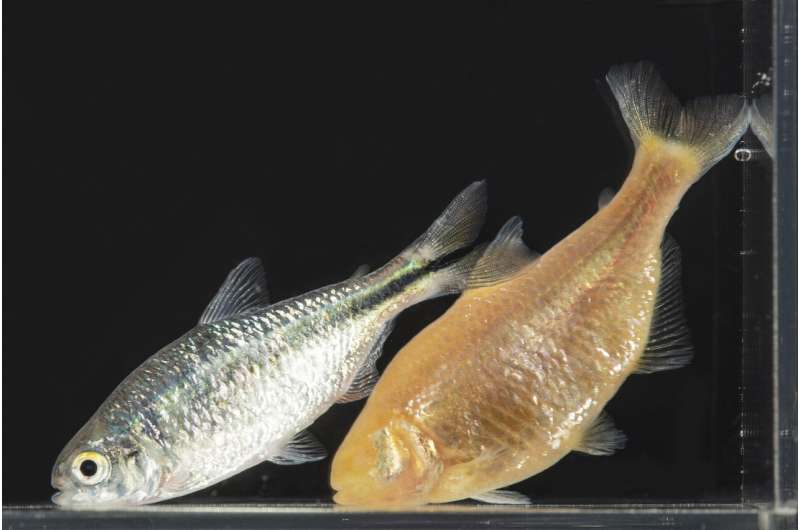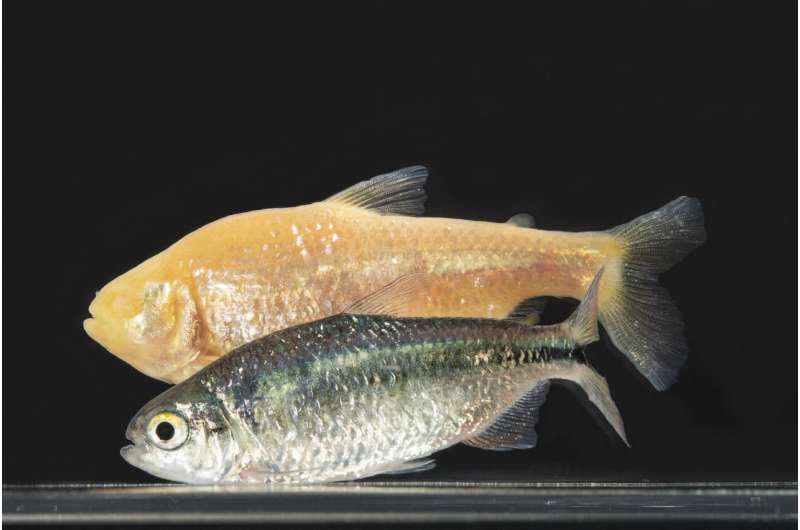Immune system adaptations in cavefish may provide autoimmune disease insight

Cavefish are seemingly insignificant: They are small, they live in tucked away places humans rarely go, and they're quite common, found on every continent except Antarctica. But researchers from the Stowers Institute for Medical Research see them as a potential way to understand more about the rise in autoimmune diseases in humans.
"Cavefish present us with an opportunity to ask, 'How does an immune system evolve when there are no parasites?'" explains Robert Peuss, Ph.D., postdoctoral research associate in the laboratory of Nicolas Rohner, Ph.D., at the Stowers Institute.
That's because, like cavefish, most humans are now living in environments that are relatively free from parasites. And like cavefish, humans have an innate and an adaptive immune system that protects them from potential parasites. But unlike cavefish, the human immune system sometimes looks for something to attack even when parasites aren't there, while the cavefish have evolved an immune system that remains balanced even in the absence of parasites.
"One hypothesis is that certain parasites help to balance our immune system responses. In the absence of these parasites, this balance can be disturbed and as a consequence the immune system attacks our own cells in the body," says Peuss. The question of why one person's immune system is affected while another is not is still a question that puzzles many scientists around the world. And we need answers soon! Autoimmune diseases, such as type 1 diabetes, now affect up to 23.5 million Americans according to the National Institutes of Health, and those numbers are rising.
Advances in modern hygiene and medical treatments have improved health and increased life expectancy, but "it's a relatively new situation for us, so evolutionary processes haven't had time to provide a way to deal with it," says Rohner, assistant investigator at Stowers. "But cavefish have been in these parasite-free caves for 150,000 years," which is a much longer time for evolution to come into play, and why the research team decided to take a closer look at cavefish.
In this study, published online July 20, 2020, in Nature Ecology & Evolution, Stowers researchers evaluated the environments of the Pachón cavefish and the closely-related Río Choy river (or surface) fish in Mexico. The fish look vastly different. For example, cavefish have much more fatty tissue, which helps them survive in a nutrient-scarce environment with infrequent feeding opportunities. But they are very close members of the same species, which make them suitable candidates for comparison. Also, surface fish live in parasite-rich environments, making them a natural type of control group for cavefish.
"We found an incredible number of parasites in surface fish—in the gut, skin, liver, gall bladder—everywhere. But we didn't find any parasites in the cavefish," says Peuss. "It's not too surprising, because caves are a biodiversity-deprived environment. There are very few animals there, so there's less of a chance for parasites to find the hosts they need to survive."
Then, in the lab, the researchers looked at the innate and adaptive immune system of both types of fish. The innate immune system is the first line of defense against parasites and triggers an unspecific inflammatory response as a broad defense strategy, while the adaptive immune system is usually slower in mounting an immune response but this response is highly specific. The first observation the team made was that, compared to surface fish, the cavefish innate immune system is much more sensitive when confronted with a potential threat, resulting in a stronger inflammatory response.
Interestingly, the team found that cavefish produce fewer cells that make up the innate immune system. This reduction in innate immune cells could potentially compensate for the increased sensitivity. But is the decreased number of innate immune cells in cavefish purely a consequence of fewer parasites in the cave, or are there other benefits from producing fewer of these cells that drive inflammation?

To answer this question, Rohner and his team looked at the body fat levels of the cavefish. Increased fatty tissue would normally increase inflammation, as well—it's true in humans. But when the researchers examined the cavefish, that wasn't the case. Cavefish, which have much higher body fat levels than surface fish, did not show higher levels of inflammation.
"The reduction of innate immune cells in cavefish compared to surface fish is probably the cause for the lack of the inflammatory response," Peuss says. "This is particularly interesting since we know that in humans, higher levels of fatty tissue often mean a higher degree of inflammation, which can lead to secondary diseases such as type 2 diabetes."
Peuss points out that these findings bring about further questions to explore. For instance, they don't know the genetic factors that lead to the reduced production of innate immune cells in cavefish. The next step in this research is to try to identify those factors, and see if there might be similar factors in humans.
"It's really interesting that there are parallels with human health in terms of being hypersensitive in an environment where there are hardly any parasites, but that's already been shown in other vertebrates in labs since labs are parasite-free by design," Peuss says. "With the cavefish, we have an example to study how it developed in an environmental setting, and to look for a genetic basis of these traits."
Lay Summary of Findings
Similar to people, cavefish live in an environment with a reduced number of parasites. Unlike people, however, cavefish have had much more time—about 150,000 years—to adapt to these conditions. To learn more about how a low-parasite environment may shape the evolution of a host's immune system, researchers from the laboratory of Nicolas Rohner, Ph.D., at the Stowers Institute for Medical Research examined the impact of decreased parasite abundance and infection on the evolution of the cavefish immune system.
In the study, the Stowers scientists and their collaborators characterized the cavefish immune system and how it responds to threats, compared to that of closely-related river fish from a parasite-rich environment. Their findings, published online July 20, 2020, in Nature Ecology & Evolution, show that cavefish differ in their sensitivity toward immune stimulants and have a different composition of immune cells, including a reduction of the immune cells that play a role in inflammation. In future studies, the scientists hope to identify genetic factors involved in cavefish immune system evolution. This research could provide clues about the development of immune system disorders and potentially human autoimmune diseases, where the immune system attacks its own body.
More information: Adaptation to low parasite abundance affects immune investment and immunopathological responses of cavefish, Nature Ecology & Evolution (2020). DOI: 10.1038/s41559-020-1234-2
Journal information: Nature Ecology & Evolution
Provided by Stowers Institute for Medical Research



















